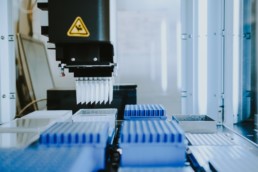Growing up as a huge fan of technological marvels and futuristic works, I remember my excitement following any news about artificial intelligence and robotics, and how I imagined a world where humans and machines worked together towards similar goals. Curiously, now that I’ve fully integrated into the field of science, it certainly seems that we are heading towards that reality.
We are immensely fortunate, it must be said, to be present to witness such a rapid shift in technology within the manufacturing industry. After centuries of gradual progress, humanity has practically begun to fly from one discovery to the next, and we have taken less than five decades to move from the third iteration of the Industrial Revolution to what has now been confirmed to be an age of Industry 4.0.
Big data, simulation, the cloud, and augmented reality are just a few of the concepts that are mentioned as being the pioneers behind this transformation of manufacturing practices, but the one among them that is the most impressive is the science behind advanced robotics and automation.
Why automation is the logical next step in manufacturing
If you wish to sum up industrial manufacturing around a certain pair of parameters, it must be those related to operational efficiency and viability: cost and time. If something can be created quickly but is too expensive, then it is a venture not worth chasing; meanwhile, if it can be made for cheap but takes too long to create, any interest in completing the project will soon evaporate.
A manufacturing plant, laboratory, or research department in a company can only accomplish so much during its working schedule, in the sense that there is often a lot of time wasted on menial tasks, and these auxiliary duties can help distract the attention of researchers from the more crucial phases of a project.
Fortunately, since the advent of the 21st Century, we have seen immense growth in the logic and autonomic capabilities of robotics, and the range of tasks that artificial intelligence can perform has become not only more widespread, but also more specific.
In other words, robots are being introduced to specialized duties that would otherwise consume the attention of workers, boosting time efficiency to levels that have been impossible to reach under human intervention. After shifting to automated systems, companies have reported a massive increase in their productivity, and human workers – still as vital as ever – have found time to focus on the creative side of things, such as the development of intricate workflow protocols and furthered interpretation of such data produced.
Forward-thinking companies in the field of biotechnology, including the pharmaceutical industry, have found the largest and most immediate benefits from shifting to robotics: dozens of daily tests have now become one hundred thousand daily tests, and these technologies have allowed companies to produce better drugs in less time than before. This in turn has allowed them to see six-figure annual savings and better uses for their project funding (see Neurocrine’s case study on using sample storage and liquid handling marvel, Verso, here).
However, this is where we have to ask the main question: how is our own industry – chemical manufacturing – faring with automation and what high throughput technologies are capable of discovering, optimizing, and commercializing in this next Industrial Revolution?
Advanced robotics in the chemical industry – a technological revolution
In the chemical manufacturing industry, time is of the essence: clients require novel molecules and formulations, often as quickly as they can, for projects that are highly time-sensitive. This isn’t an easy situation for either the client or the company serving them – the development of a safe, stable, and effective molecule can take up to a year, and many clients are not willing to wait that long.
For laboratory workers, tasks such as simulations, assays, chemical storage, database logging, and liquid handling are all extremely time-consuming, and can quickly pile up and push the deadline further. I’ve been there, and I know for sure how many countless hours can be consumed during pipetting, storage management and labeling samples – a lot!
Thankfully, the same technology that is bringing about a fourth Industrial Revolution is now starting to change this situation, sweeping aside the obstacles of these tasks by introducing high throughput screening (HTS) technologies, which can facilitate the analysis of over one hundred thousand samples in a day.
Making use of their own integrated chemical libraries, HTS systems harness the compounded information contained in databases to rapidly analyze microsamples of nanoliters (and even picoliters) in instants, handling these tiny assay plates faster and more delicately than any human hand could manage, logging all data in milliseconds and screening it for hits on measured parameters.
Iterated tests in identical conditions may be a challenge for a human team of laboratory workers but not for a highly-advanced AI: training it to handle new conditions, as well as learning when to exclude certain samples from the assays, is a simple task that will take operators a few clicks.
When it comes to cost efficiency, HTS comes out as the obvious winner: in an industry where employees are earning six-figure salaries, time is money… and better spent on designing molecules and interacting with clients. Furthermore, the flexibility and reproducibility of using microscopic amounts of sample helps reduce expenses significantly and lowers operational risks.
Just ask Derrick Miyao, former Manager of Automation at Neurocrine Biosciences – his case study stated that the company only required slightly more than one month to obtain a return on their investment after integrating Verso into their process.
I mentioned cost and time above – with robotics, both finite resources are ideally maximized through automated methodologies to further amplify the output of such processes. In a world of Industry 4.0, automation is not just an advantage – it is simply the way forward.
A sci-fi future, except without leaving the present
The days of laboratory chemists pipetting samples and handling storage tasks are about to end, and chemical manufacturers like myself could not be happier.
With technology now so tightly in our grasp and industry combining so perfectly with it to create impressive new products, we are watching a long-awaited moment unfold before our eyes: the advancement of humanity towards a future of unprecedented progress.
As in the days when I looked at the future with curious wonder, I now observe the present with similar amazement. These are fascinating times; let’s make the most of them.



